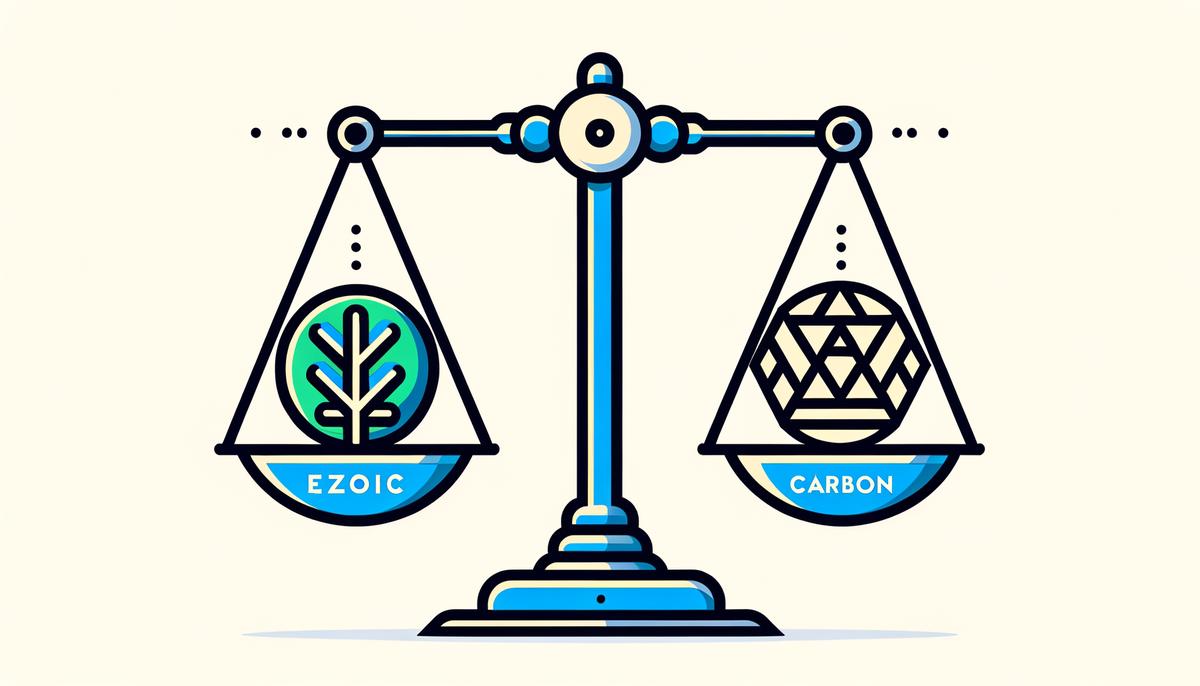Choosing the right ad network for your website requires careful consideration of factors such as entry requirements, ad quality, revenue potential, and user experience. This article compares Ezoic and Carbon Ads, offering insights to help publishers make informed decisions.
Entry Requirements
Entry Requirements
Ezoic and Carbon Ads cater to different segments of publishers. Ezoic has a clear minimum threshold of 10,000 pageviews per month, making it appealing for emerging publishers. Ezoic is flexible about content originality and adherence to Google AdSense policies, and prefers identifiable and consistent traffic.
Carbon Ads also requires websites to have at least 10,000 pageviews per month. However, Carbon Ads prioritizes websites whose audience matches the interests of their tech-centric advertisers, making it suitable for niche sites focused on design, development, and related fields. Carbon Ads emphasizes maintaining an active and well-curated website.
While both platforms have a pageview threshold, their criteria differ. Ezoic's flexibility concerning content contrasts with Carbon Ads' focused approach, preferring publishers whose audience aligns with their technology and design-centric advertising partners.
Publishers should align their site's traffic, audience, and content focus with the unique offerings and expectations of each ad network. Evaluating eligibility based on these criteria helps determine which platform might be a more accessible and beneficial pathway for monetizing digital content.
Ad Quality and Types
Ad Types and Placement
Ezoic and Carbon Ads facilitate ad-driven revenue, but their ad types and placement strategies differ. Ezoic offers a diverse range of ad types, including display, video, and native formats. This allows broader website demographics to encounter relevant ads without intrusive disruption. Ezoic's AI-driven allocation ensures ads are timely and engaging, adjusting to the visitor's interactions.
Carbon Ads has a more niche marketplace, with ads curated for a designer and developer audience. A single, neatly designed ad occupies a small portion of the screen, blending into the website like a well-integrated feature. This approach minimizes disturbance and presents users with solutions and tools relevant to their professional needs and interests.
Ezoic's variety and intelligent placement promise maximized engagement across a wider array of website genres. Its adaptive model assures publishers that their audience segments will encounter tailored ads, promoting a seamless web experience.
Carbon Ads' minimalist approach demonstrates an understanding of its audience's preference for subtle advertising. This focus on delivering high-quality, relevant ads appeals to publishers serving creative and tech professionals, where audience tolerance for disruption may be lower.
Choosing between Ezoic and Carbon Ads depends on understanding the audience's preferences. Broad-based websites with diverse traffic looking to maximize revenue through intelligent, varied ad placements may find Ezoic a good fit. Publishers with a niche focus on design and tech may prefer Carbon Ads' discreet yet highly relevant advertising.
The decision reflects how publishers perceive their audience's interaction with advertisements – as interruptions to be minimized or as valuable content to be strategically integrated.
Revenue Potential
Revenue Potential
Revenue potential is a key consideration for website owners exploring ad networks. Ezoic and Carbon Ads offer different models and deliverables, highlighting the importance of matching site characteristics to an ad platform's strengths.
Ezoic uses machine learning algorithms to optimize for overall session revenue, conceptualized through their EPMV (Earnings Per Thousand Visitors) metric. This approach maximizes publishers' earning potential by serving ads in the most contextually relevant and user-friendly environments. Ezoic offers a range of monetization features, including various ad types and integrations with multiple ad suppliers to increase competition and bid prices.
Ezoic's revenue model is dynamic, adjusting based on visitor location, device, and content interaction. This continual optimization often leads to increased RPMs (revenue per thousand impressions) for publishers. Ezoic publishers frequently observe revenue increments due to the combination of high ad quality, strategic placement, and data-driven refresh rates.
Carbon Ads operates within a more confined yet premium scope. With its narrower advertiser base and specific audience target, Carbon Ads can often command higher CPMs (Cost Per Thousand Impressions) for highly relevant ads. The focus on tech and design audiences makes Carbon a compelling choice for websites with traffic predominantly from these sectors. The stringent advertiser-selection process ensures high contextual relevance, translating to strong engagement rates, even with a single ad spot.
Carbon Ads pursues complementarity over conspicuousness; ads are designed to enrich rather than distract, creating a balance between ad visibility and user experience. However, the singular ad format may limit versatility and broader revenue generation initiatives. While individual ad placements through Carbon might fetch attractive rates, Ezoic's model provides a broader spectrum of real estate engagement, potentially leading to higher cumulative revenue.
Website owners should match their site's content and visitor profile with an ad platform. Ezoic offers versatility and dynamic optimization for broad-based audiences. Sites with a niche audience in tech and design might find Carbon Ads a higher-yielding option due to enhanced CPM rates reflective of targeted relevance and a premium advertiser pool.
Choosing between Ezoic and Carbon Ads involves recognizing not just higher CPM rates but also aligning ad formats and engagement possibilities with the unique audience matrix. The decision should align with an ad network whose revenue potential matches the depth of one's website.
Privacy and User Experience
User Experience and Privacy
In the era of privacy concerns, Ezoic and Carbon Ads offer different approaches to user experience and data sensitivity, shaping how they discern and dispatch advertisements.
Ezoic takes a non-invasive stance on user experience by combining advertisement functionality without compromising privacy. Ezoic relies on anonymized, aggregate data rather than cookies or third-party scripts that track users' internet activity. This approach respects visitor privacy while ensuring content relevance. However, Ezoic's versatile ad placements, while contributing to revenue, might disrupt the browsing experience for some users. Ezoic's algorithm strives to maintain an optimal user experience.
Carbon Ads focuses on minimizing user friction by refining ad intrusion. The singular ad format that integrates into the technical layout of websites demonstrates Carbon's commitment to user experience. The ad blends seamlessly within the content, adapting without overwhelming. This streamlined advertisement model highlights Carbon Ads' recognition of the need for discreet yet effective monetization strategies in tech and design spheres.
Regarding privacy, Carbon Ads' stance occasionally raises concerns. Their policy allows for cookie deployment and third-party data involvement, potentially leading to more granular tracking of user interactions. While this may be reassuring for advertisers, it requires publishers to be vigilant about user consent.
Ezoic's modular approach to preserving user experience without relying on personal data aligns with web-privacy concerns. Carbon Ads, with its focus on ad design and layout for tech audiences, takes a more traditional approach to privacy, albeit without defaulting on the need for respectful user engagement.
The interplay between privacy policies, ad delivery, and user experience underscores the evolved discernment of both Ezoic and Carbon Ads. Publishers must align their adherence to privacy norms with their ambition for a frictionless user experience and revenue actualization. As media consumption moves towards greater virtual privacy, aligning with a platform that prioritizes this becomes essential for publishers upholding modern web ethics.

Support and Community
Support and Community
Ezoic and Carbon Ads place a strong emphasis on nurturing their communities through accessible support infrastructures and community-oriented initiatives.
Ezoic offers an extensive repository of self-help resources, including tutorials, articles, and a dedicated support hub. For high-traffic entities, Ezoic provides direct human engagement through publisher success managers. This combination of personal touch and digital convenience demonstrates Ezoic's commitment to fostering a thriving and informed publisher community. Their prompt responsiveness aligns with their AI-driven, user-centric advertising philosophy.
Ezoic also cultivates an environment of mutual learning and shared growth through forums, webinars, and meet-ups. This communal camaraderie supplements Ezoic's technological prowess, emphasizing the value of human connection and collaboration.
Carbon Ads, with its artisanal essence and boutique operational scale, provides support through closely-knit, direct interactions. Publishers linked with Carbon Ads often highlight the sense of belonging to a concentrated enclave of tech and design-centric entities. Support interactions are personalized, reflecting Carbon's ethos of quality over quantity.
Carbon Ads weaves publishers, advertisers, and end-users into an interconnected tapestry characterized by specialized content and exclusive networks. This tight-knit ecosystem propels not only fiscal growth but also fosters kinship rooted in shared goals and aspirations unique to technology and design.
The interplay between support and community forms a pivotal criterion for publishers deciding between Ezoic and Carbon Ads. Ezoic envelops users in an expansive shield of resources accentuated by personal success guidance, while Carbon Ads nurtures its niche through tailored interactions and community interlinkages.
The ad networks' support and community initiatives demonstrate their understanding that publisher satisfaction extends beyond ad revenues. It grows through support responsiveness, resource availability, and fostering a community that vibrates with shared fervor and mutual upliftment.
Conclusion
In digital advertising, the choice between Ezoic and Carbon Ads depends on a publisher's specific needs and audience characteristics. Aligning your site's content and visitor profile with an ad platform's strengths is crucial for maximizing your digital content monetization efforts.
Consider the following key factors when choosing between Ezoic and Carbon Ads:
- Entry Requirements: Ensure your website meets the pageview and content criteria for each platform.
- Ad Types and Placement: Evaluate how each network's ad formats and placement strategies align with your audience's preferences and tolerance for advertising.
- Revenue Potential: Assess which platform's revenue model best suits your website's traffic profile and niche.
- User Experience and Privacy: Consider how each network's approach to user experience and data privacy aligns with your website's values and audience expectations.
- Support and Community: Evaluate the level of support and community engagement offered by each platform to ensure a positive partnership.
By carefully weighing these factors, publishers can make an informed decision between Ezoic and Carbon Ads, ultimately selecting the ad network that best positions their website for success in the competitive landscape of digital advertising.
- Ezoic. Ezoic Review. Accessed June 1, 2023.
- Carbon Ads. Advertise. Accessed June 1, 2023.
- Google. AdSense Program Policies. Accessed June 1, 2023.
- Ezoic. Ad Tester. Accessed June 1, 2023.
- Carbon Ads. Advertisers. Accessed June 1, 2023.
- Ezoic. EPMV. Accessed June 1, 2023.
- Carbon Ads. Publisher Benefits. Accessed June 1, 2023.
- Ezoic. Privacy Policy. Accessed June 1, 2023.
- Carbon Ads. Privacy Policy. Accessed June 1, 2023.
- Ezoic. Resources. Accessed June 1, 2023.




